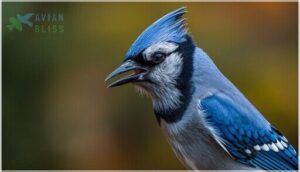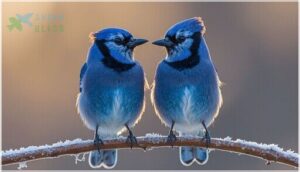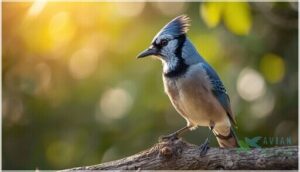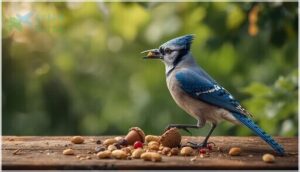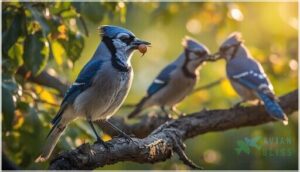This site is supported by our readers. We may earn a commission, at no cost to you, if you purchase through links.

You’ve probably noticed that vivid blue flash darting through your backyard, scolding everything in sight with a voice that could wake the neighbors. Blue Jays aren’t just noisy show-offs—they’re actually feathered geniuses who plant entire forests, one hidden acorn at a time.
These charismatic corvids can mimic hawk calls to scare off competition, remember thousands of hiding spots across a square mile, and even use tools when the situation calls for it. But here’s what really sets them apart: that stunning blue color you admire isn’t even blue at all—it’s an optical illusion created by microscopic structures in their feathers.
From their surprisingly tender family bonds to their sneaky food-caching strategies, these birds pack more personality and smarts into their 11-inch frames than most creatures twice their size.
Table Of Contents
- Key Takeaways
- Blue Jay Appearance and Identification
- Unique Blue Jay Behaviors
- Blue Jay Diet and Feeding Habits
- Habitat, Range, and Migration
- Intelligence, Social Structure, and Lifespan
- Frequently Asked Questions (FAQs)
- Are Blue Jays intelligent birds?
- Where do blue jays live?
- Are Blue Jays aggressive?
- Are Blue Jays really blue?
- What makes Blue Jays so interesting?
- What are some interesting facts about blue jay birds?
- What do you know about Blue Jays?
- Why is a Blue Jay called a Jay?
- How many Blue Jays are there?
- What are five facts about Blue Jays?
- Conclusion
Key Takeaways
- Blue Jays aren’t actually blue—their vibrant color comes from microscopic feather structures that scatter light, not from pigment, and if you crushed a feather, you’d see it’s brown underneath.
- These birds are accidental forest architects, caching up to 5,000 acorns per season with 90% accuracy in selecting viable seeds, but only recovering about 25%, leaving thousands to germinate into new oak trees.
- Blue Jays demonstrate corvid-level intelligence through tool use, vocal mimicry (including hawk calls to scare competitors), and the ability to remember thousands of hiding spots across a square mile.
- Despite forming lifelong monogamous bonds and showing impressive cognitive abilities, most Blue Jays face tough survival odds with an average lifespan of just seven years and fewer than 5% making it past their first year due to predators, disease, and urban threats.
Blue Jay Appearance and Identification
You’ve probably spotted a Blue Jay and thought, “Wow, that’s a seriously blue bird.” But here’s the thing—those vivid feathers aren’t quite what they seem.
Let’s break down what makes these birds so visually striking and surprisingly easy to identify once you know what to look for.
Plumage Color and Light Reflection
You might assume Blue Jay feathers contain blue pigment, but they don’t—what you’re seeing is structural coloration through light scattering. Their feather nanostructures scatter short blue wavelengths back to your eyes while absorbing reds and yellows.
Blue Jay feathers aren’t actually blue—they scatter light through microscopic structures, creating the vivid color you see
This evolutionary adaptation for species recognition outlasts pigment-based colors, never fading over time. Crush a feather and you’ll see brown—proof the blue exists only in how light bounces off microscopic air pockets. This phenomenon is known as light scattering.
Crest, Bridle Patterns, and Unique Markings
Beyond feather coloration, you’ll notice Blue Jays communicate through crest position—raised when aggressive, flattened when relaxed. Their black “bridle” patterns around the face vary between individuals, helping with Blue Jay identification and recognition among flock members.
Wing markings feature bold black-and-white barring, while structural feather patterns rarely show pattern asymmetry. These Blue Jay characteristics make each bird uniquely recognizable through feather structure details.
Blue Jays are omnivores, consuming nuts, seeds, and insects as part of their varied diet.
Size, Weight, and Sexual Similarity
While those unique markings help you spot individual birds, Blue Jay physical appearance shows minimal sexual dimorphism—males and females look nearly identical in plumage.
Size variation follows Bergmann’s rule: northern birds measure 22-30 cm and weigh around 92 grams, while southern populations average lighter at 74 grams.
Morphometric data reveals males are slightly larger, though this sexual monomorphism makes field identification tricky without close observation.
Unique Blue Jay Behaviors
Blue Jays aren’t just pretty faces—they’re seriously clever birds with some quirky habits that’ll make you look at them differently. From their impressive vocal tricks to their bizarre grooming routines, these birds have developed behaviors that scientists still find fascinating.
Let’s explore three standout behaviors that show just how unique Blue Jays really are.
Complex Vocalizations and Mimicry
You’ve probably heard Blue Jay vocalizations echo through your neighborhood—those loud, varied calls aren’t random noise. These birds develop their complete vocal repertoire within six months, mastering everything from contact calls to hawk mimicry.
What’s fascinating is their capacity for vocal learning throughout life, picking up regional dialects and even imitating Red-tailed Hawks to scare off competitors.
Their call variation fulfills specific purposes: harsh “jeer” calls for mobbing predators, melodic contact notes for maintaining family bonds, and mimicry as a clever survival tactic in avian communication.
Anting and Feather Maintenance
When you spot a Blue Jay rubbing ants all over its feathers, you’re witnessing anting—an instinctive behavior that appears even in hand-raised birds. They target ants with formic acid in their acid sacs, which helps discharge defensive chemicals before eating them.
This fascinating ritual has multiple purposes:
- Safely preparing ants for consumption by emptying their defensive sprays
- Supporting feather maintenance during molting patterns when jay feather replacement peaks
- Contributing to parasite control, potentially enhancing feather brightness by up to 10%
Food Hoarding and Tool Use
During peak hoarding periods, a single Blue Jay can stash up to 107 acorns daily, with each acorn hidden separately across a mile-wide range. Their cache recovery rate hovers around 25%, making them accidental forest architects through acorn dispersal. What’s striking is their captive tool use: food-deprived jays in labs have wielded newspaper strips to rake food pellets closer, though wild tool-use triggers remain unconfirmed.
| Hoarding Behavior | Recovery & Impact | Tool Use |
|---|---|---|
| 3,000 acorns cached per bird over 28 days | Only 25% of caches recovered | Triggered by food deprivation in captivity |
| 107 acorns hidden daily during peak periods | Unclaimed acorns boost oak dispersal | Newspaper strips used to rake food closer |
| Each acorn buried in separate location | Keystone seed disperser role in forests | No verified wild tool use documented |
| Cache sites up to 1 mile from source | Higher germination rates for cached acorns | Tool-use frequency increases with visible food |
Blue Jay Diet and Feeding Habits
Blue Jays aren’t picky eaters—they’ll gobble up everything from insects and seeds to the occasional frog or bird egg. Their adaptability at the dinner table is one reason they thrive in so many environments, from deep forests to your backyard feeder.
Let’s look at what fuels these intelligent birds and how their eating habits actually benefit the ecosystem around them.
Omnivorous Diet and Favorite Foods
You might be surprised to learn that Blue Jays are true omnivores, with their diet shifting dramatically throughout the year. Here’s what they’re actually eating:
- Vegetable matter dominates – up to 75% of their annual intake consists of seeds, nuts, and berries, with acorns topping their preference list
- Insects round out spring and summer meals – caterpillars, beetles, and grasshoppers provide essential protein
- Occasional animal consumption occurs – though rare, they’ll eat eggs or carrion when protein needs spike
This dietary adaptation keeps them thriving year-round.
Acorn Caching and Oak Tree Dispersal
Blue Jays are nature’s original forest planters. Each fall, you’ll find them hauling up to five acorns per trip across distances exceeding a mile—some recorded at 1.9 kilometers.
They cache up to 5,000 acorns seasonally, selecting viable seeds with 90% accuracy. Here’s the amazing part: they only retrieve about 25% of cached acorns, leaving thousands to germinate and establish new oak stands.
Feeding at Backyard Bird Feeders
You’ll notice something fascinating about feeder preferences—Blue Jays linger 13.24 seconds at covered feeders versus only 9.36 seconds at exposed ones, proving they value safety over convenience.
Smart bird feeding means matching feeder design to their seasonal diets and activity patterns.
- Peanuts and sunflower seeds dominate their choices, especially in a tray feeder with ample space
- Mid-morning and late afternoon mark peak feeding times when they’re most active at bird feeders
- Strategic placement near cover encourages longer visits while balancing visibility and security
Habitat, Range, and Migration
Blue Jays aren’t homebodies—they’re adaptable wanderers that pop up in forests, backyards, and city parks across much of North America. Whether they stick around all year or pack up for a winter road trip depends on factors scientists are still piecing together.
Let’s look at where you’ll find these striking birds and what drives their seasonal movements.
Geographic Distribution and Preferred Habitats
You’ll find Blue Jays across eastern and central North America, from southern Canada to Florida and Texas. Their range expansion since the 1940s has pushed them west into British Columbia and along the Pacific Coast.
These adaptable birds favor oak and beech forests but thrive equally in urban parks, suburban yards, and riparian habitats—wherever wooded areas and reliable food sources meet their needs.
Migration Patterns and Seasonal Movements
What drives Blue Jay migration patterns isn’t straightforward—these birds don’t follow predictable routes. Less than 20% of northern populations actually migrate, and individuals may switch strategies year to year based on acorn abundance and weather.
Key migration facts you should know:
- Spring flocks of 5-250 birds travel north April through May
- Young jays migrate more often than adults
- Southern populations rarely leave their territories
- Genetic factors and winter food source availability determine movement
Adaptation to Urban and Suburban Areas
While migration keeps researchers guessing, urbanization has pushed Blue Jays into surprising territory. You’ll find these backyard birds thriving in cities—their urban vocalizations now pitch 1-3 kHz higher to cut through traffic noise.
They’re nesting in your garden shrubs and cemetery trees with 72% success rates, outpacing rural cousins. Diet changes are obvious: 89% raid bird feeders for sunflower seeds, though habitat loss means 17% less acorn caching.
Population shifts favor cities, where densities hit 5.2 pairs per hectare. Urban threats? Window collisions claim 12% of juveniles, and cats cause 23% of nesting failures.
Intelligence, Social Structure, and Lifespan
Blue jays aren’t just pretty faces—they’re genuinely smart birds with complex social lives that’ll surprise you. These feathered Einsteins form tight bonds with their mates and can live much longer than you’d expect for a backyard bird. Let’s look at what makes their intelligence, relationships, and longevity so impressive.
Problem-Solving and Learning Abilities
Ever wonder how Blue Jay intelligence stacks up against other clever birds? You’ll be amazed to learn they rival crows in problem-solving, using tool use to extract hidden spiders and pulling cords to reach food.
Their cognitive boldness shines through observational learning, numerical skills that help them pick larger food quantities, and even false caching to outsmart thieves—true avian intelligence at work.
Social Bonds and Monogamous Pairs
Beyond their smarts, you’ll find Blue Jays form monogamous pairs that usually last a lifetime—true family bonds in the bird world.
Both parents share nest-building, incubation, and feeding duties during cooperative breeding, strengthening their pair bond duration through gift exchanges and mutual preening year-round.
These monogamous bonds create social hierarchy within family groups, boosting reproductive success as young jays sometimes help raise the subsequent brood.
Lifespan and Survival Challenges
Despite their cleverness, you’ll notice Blue Jays face serious survival challenges. The average Blue Jay lifespan in the wild hovers around just seven years, though unusual individuals reach 17.
Predator impact from hawks and owls, disease vulnerability including West Nile Virus, habitat loss from development, and climate effects all threaten populations. Urban threats like free-roaming cats compound these pressures, with fewer than 5% surviving past their first year.
Frequently Asked Questions (FAQs)
Are Blue Jays intelligent birds?
You’ll be amazed by their smarts—Blue Jays rank among the brightest of corvids, mastering tool innovation, mirror recognition, and social learning.
They also display deceptive caching behaviors that reveal genuine bird intelligence and problem-solving prowess.
Where do blue jays live?
You’ll find blue jays throughout eastern and central North America, from southern Canada to Florida.
They love wooded areas with oaks, adapting brilliantly to urban parks and suburban backyards wherever trees grow.
Are Blue Jays aggressive?
You’ve probably seen their swagger at the feeder—like tiny feathered mobsters running a protection racket. Blue Jays can be aggressive, especially during breeding season when territorial defense kicks in and dominance hierarchies matter most.
Are Blue Jays really blue?
Blue Jays aren’t truly blue—they lack blue pigment entirely. Their feathers contain brown melanin, but structural coloration creates that vibrant blue through light refraction.
It’s all about feather microstructure scattering light, an impressive evolutionary advantage.
What makes Blue Jays so interesting?
What makes these birds fascinating is their combination of bird intelligence, blue jay mimicry, and communication skills, and social complexity.
From acorn dispersal to tool use, blue jay behavior reveals surprising cognitive abilities.
What are some interesting facts about blue jay birds?
You’ll be amazed by Blue Jay intelligence and tool use—they recall up to 5,000 acorn cache locations with 90% accuracy, demonstrating impressive cognitive skills.
This ability contributes to essential acorn dispersal, which aids forest regeneration.
What do you know about Blue Jays?
These eye-catching corvids aren’t just another bird on the block—they’re actually nature’s con artists with genius-level smarts.
You’ll spot their signature blue plumage, hear their hawk mimicry, and discover why they’re ecological oak-planting machines worth celebrating.
Why is a Blue Jay called a Jay?
The name “jay” comes from the bird’s distinctive call that literally sounds like “jay.”
You’ll hear these noisy vocalizations echoing through forests—loud, harsh jeers that inspired both the common name and derogatory usage in cultural symbolism and linguistic evolution.
How many Blue Jays are there?
You’ll find around 17 million Blue Jays worldwide, with over 13 million calling the US and Canada home. The global population has declined roughly 27-28% since 1966, though regional densities vary greatly across bird habitats.
What are five facts about Blue Jays?
Like puzzle pieces forming a vivid picture, these Blue Jay facts reveal their magic: their interesting plumage results from light reflection, vocal mimicry includes hawk calls, acorn caching aids forests, habitat adaptations span cities to woodlands, and social learning shapes behavior.
Conclusion
Next time you spot one of these backyard rock stars strutting across your lawn, you’ll know there’s a lot more going on behind that vibrant crest than meets the eye.
These facts about blue jays reveal a bird that’s equal parts forest engineer, vocal impersonator, and devoted partner. They’re not just pretty faces with loud opinions—they’re clever survivors shaping the landscape one cached acorn at a time.
That’s worth celebrating.


